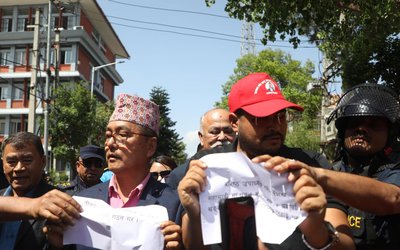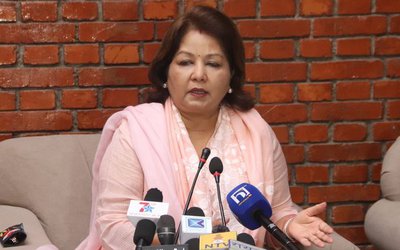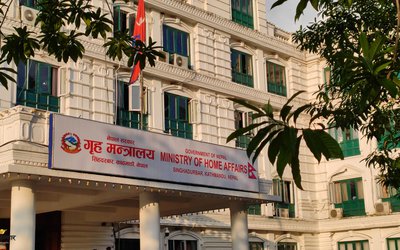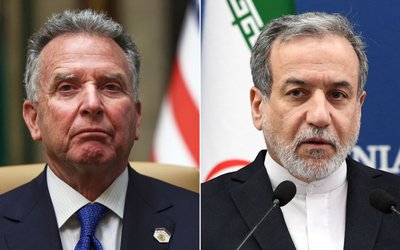
One Friday afternoon, this cool man rushed to disputed areas of Udayapur to settle the issues with people and start the construction of a tower. The next evening, he reached Gonger, the site of 456 MW Upper Tamakosi Project.
Kul Man Ghising, Managing Director of Nepal Electricity Authority (NEA), also spent his time at the micro-level. Along with attending the meeting at the center on national level issues and performing his day to day work, MD Ghising spared adequate time to deal with the issues at the site level.
As it is said, all the hard work -- sacrifice, sleepless night and struggle -- only pays off when it meets the right action plan. This is what one can see being used by MD Ghising.
Had he not spent adequate time at the micro-level, the present progress would not be achieved. With a strong dedication and commitment, MD Ghising sacrificed his time targeting the projects.

He even shortened the mourning period of the death of his father and attended the emergency meeting in the first week of July when floods badly affected some of the hydropower plants. MD Ghising moved immediately to the load dispatching center to manage the shortfall of electricity caused by the disruption of the power plants.
When Ghising was appointed managing director of NEA on 14 September 2016 by the government of Nepal, the energy sector was in a dire situation.
It was a time when the country had been passing through an unceasing load shedding with 6 to 8 hours of power cut during the rainy season and up to 14 hours of outage in winter. At work for almost two decades, Nepal’s prolonged load-shedding had badly affected economic growth as well.
As the country had been facing chronic load shedding, Nepal Electricity Authority was at the state of financial bankruptcy. The net loss till 2015/016 was Rs. 34.61 billion which came down to Rs.8.89 billion in that fiscal year.
As Nepal was facing an awful lot of darkness, with NEA, the sole public entity of the energy sector, in virtual bankruptcy, the graph of the loss was going up. Annual electricity loss was 25.78 percent when about 63 percent of the population was connected to the national grid.
Even for a professional and career person like MD Ghising, it was a very hard time to choose the areas of reform. Preparing a set of action plans to change NEA and energy sector before his appointment, Ghising was able to transform NEA by making all efforts on supplying continuous, reliable and affordable power to its consumers.
“For the last four years, I have devoted my whole effort to convert the darkness into light, to make the institution from a loss incurring one to a profit venture, that is now a strong, disciplined and respected institution,” said Ghising.

These plans required programs to increase the generation capacity, reduce technical loss, increase the access of electricity, reduce unnecessary expenditure, expand transmission lines, improve and expand substation, administrative reform and ensure regular, dependable, adequate and quality supply.
MD Ghising draws an action plan carefully with step after step in view. Just a few months after taking the charge, Ghising announced ending the load shedding except for the industrial sector.
Even in such a dire situation, NEA had supplied 20 hours of electricity to the industry except for four peak hours. This helped to increase the productivity of the industries which were facing low productivity. From the second year, NEA announced the end of load shedding in the industrial sector as well. This had a direct impact on Nepal’s annual Gross Domestic Product. Following the end of load shedding, GDP growth rose up to 7 percent with 2 percent contributions from the ending of load shedding.
“During my first-year tenure, NEA was successful to make net Rs. 1.47 billion in profits. After that NEA’s net profit has increased. Second-year, the profit was raised to over Rs. 2.85 billion but in the third year, the profit was over Rs.7 billion. This year the profit is projected to go over Rs.11 billion. Four years ago, NEA had to knock the door of government. Now, NEA is one of the most profitable and economically strong public entities in the country,” said MD Ghising.

From negative cumulative loss, NEA has now cumulative profit -- from Rs.34.61 billion to the Rs.12.23 billion. This year it is projected to get Rs. 5 billion in profit.
Following ending the load shedding, NEA launched a campaign with the target to reduce technical and non-technical electrify loss. Implementing proper planning, NEA achieved remarkable success to reduce the loss.
From 25.78 percent losses four years ago, it is projected to decline to 15.25 percent now. In the first year, it declined to 22.9 percent followed by 20.45 percent and 15.32 percent last year. In the last four years period, a total of 11 percent loss came down. His other mission was to increase the access of electricity. “From merely below 60 percent, 86 percent of people have access to the grid. If off-grid is included, access to electricity is now 95 percent,” said MD Ghising.
Incomplete Projects
From hydropower projects to transmission lines, there are numbers of projects lying incomplete for a long time. Due to various managerial, legal and land issues and disputes of local people, almost over 80 percent of transmission line projects were in disorder. This is also the same as the distribution and hydropower projects.
Numbers of incomplete hydropower, transmission and distribution projects have completed during the period. Some of the projects are under the process of being completed.
As the transmission lines, substations and distribution systems have been completed, the consumption of electricity has increased in the last four years. In the fiscal year 2015/16, 4,77,38,00000 units of electricity were consumed. In 2016/17, the consumption went to 5,55,73,00000 units followed by 6,33,8100000 units in the last fiscal year. This year’s project is 6,52,8700000 units. Currently, per capita consumption of electricity is 245 units per individual. It is 80 percent higher than what it used to be four years ago.
During the period, NEA has made major progress in the construction of cross border transmission line. The completion of 132 kV second circuit Kushaha-Kataiya and Raxual-Parwanipur and 400/200 kV substation was a major achievement. With the completion of the substation, Dhalkebar-Muzaffarpur 400 kV transmission line is in the final stage of charge. Similarly, the capacity of Tanakpur 220/132 kV’s 50 MVA Transformer increased to 100 MVA. Following the completion of these works, the capacity of Nepal-India power transmission reached 1500 MW with 1200 MW new capacity. As Upper Tamakosi and other projects are in the process of completion, Nepal will have surplus electricity in the next year’s rainy season -- these transmission lines will help us export our surplus electricity.

Similarly, the 400 kV Butwal-Gorakhpur Transmission line is now at the implementable stage. Similarly, the construction of 132 kV Mainhiya Rupandehi and Samptiya Utter Pradesh Transmission line has already started. Likewise, Inaruwa, Purnia and Lamai Bareli 400 kV Transmission line and 132 kV Kohalpur-Nanpara (Utter Pradesh) Transmission line feasibility study has already completed.
Nepal Electricity Authority and State Grid of China have already signed a Memorandum of Understanding to construct Ratomate-Rasuwagadhi-Kerung 400 kV Transmission line. In Nepal’s side, the feasibility study has already completed as well as the Environmental Impact Assessment.
The length of the 66 kV transmission line is nearly doubled in the last four years. In 2016/017, there was 2911 circuit KM 66 kV Transmission line. At the end of this fiscal year, the length reached 4275.2 circuit kilometers. This is about 74 percent higher than four years ago.
Following the end of load shedding and improvement of transmission and distribution system, the consumption of electricity has increased by 80 percent.
Hydropower
With a delay in the completion, it has not only increased the cost of hydropower projects but also affected the generation. Three major hydropower projects with 104 MW generating capacity were lying as sick projects with no hope for completion. Following the earthquake, hydropower projects with 830 MW generating capacity were facing uncertainty.
With MD Ghising’s intervention, 14 MW Kulekhani III, 30 MW Chamelia and 60 MW Trishuli 3 A projects started generation two years ago. Now, the 456 MW Upper Tamakosi is in the final stage of completion, expecting to start generation by the end of November. Similarly, 102 Middle Bhotekoshi, 111 MW Rasuwagadhi and 57 MW upper and lower Sanjen are preparing to complete by the end of this fiscal year.
For the first time in its history, NEA has reduced the consumer tariff. According to recent decisions, electricity will be supplied free of charge for up to 10 units at Rs.30 minimum charge. In totality, the tariffs were also reduced by 8-9 percent. NEA removed dedicated and trunk line additional charge for industry and business complex. Similarly, the tariff for irrigation and drinking water was also reduced.
The Speed On
Although the COVID-19 pandemic has badly affected various development projects all over the country, it has had very nominal impacts on NEA Projects. NEA was able to achieve 82.29 percent physical progress in its projects related to power generation, transmission and distribution in the last fiscal year 2019-20 and also achieved financial progress of 81.23 percent.
Of the Rs 58.04 billion allocated for projects run by the government, foreign and NEA sources, Rs 47.14 billion has already been spent.

Similarly, 92 percent of the budget that was allotted for expansion, strengthening and up-gradation of distribution lines to increase access to electricity and provide reliable and quality services to consumers was utilized and 100 percent physical progress was achieved on this front.
Ghising, managing director of NEA, said the overall financial and physical progress was encouraging even though the work of projects under construction was badly affected due to COVID-19.
“Problems created due to procedural hurdles in forest land use, land acquisition, disruptions in transmission and distribution lines are common obstacles faced by all the projects,” he said.
Minister for Energy, Water Resources and Irrigation Barshaman Pun and Secretary Dinesh Kumar Ghimire has helped him whenever there has been a need for policy intervention.
After the government decided to resume construction works of projects even during the lockdown by adopting safety measures related to health, concerned officials, including the Minister for Energy, Water Resources and Irrigation and Secretary, played a crucial role.
“Minister Pun and Secretary Dinesh Kumar Ghimire provided immense support to enable the projects to move forward even in such difficult circumstances. Had they not they backed me, the progress would not have been made,” said Ghising.
According to him, some projects have been completed and some have reached the final stage of construction. Ghising further stated that the financial and physical progress of the projects would have been higher if the coronavirus pandemic had not occurred as works of some projects have not been completed yet due to the impact of the contagion.
Out of the Rs 7.80 billion allocated for the construction of power projects in the last fiscal year, Rs 5.53 billion has been spent. Expenditure and physical progress of generation projects was 70.82 percent and 76.83 percent, respectively.
The power generation side includes construction, maintenance and other works of hydropower projects. Last year, 15 projects of the private sector were completed and 135 megawatts of electricity was added to the national transmission system.
NEA is conducting a detailed study of 1,061MW Upper Arun, 635MW Dudhkoshi, Upper Modi A, Tamakoshi-5 hydropower projects, among others. Of the Rs 1.95 billion allocated for the study of hydropower projects, only 26.48 percent has been spent. The physical progress of these projects stands at 33.39 percent. Ghising said that the study of the projects was affected by the coronavirus.
Meanwhile, the 456-MW Upper Tamakoshi and 140- MW Tanahu hydropower projects are under construction through subsidiary companies of NEA. The construction of Upper Tamakoshi is targeted to be completed very soon.
Out of 77 districts across the country, 15 have been fully electrified till date.
In the last fiscal year, 11 districts were fully electrified. Earlier, only Parbat, Syangja, Kathmandu and Bhaktapur were fully electrified. NEA fully electrified Dhankuta, Sunsari, Siraha, Dhanusha, Mahottari, Bara, Parsa, Nuwakot, Kapilvastu, Gulmi and Bardiya in the last fiscal year 2019-20.

However, NEA had set a target of electrifying 40 districts in the last fiscal year but its target could not be achieved due to COVID-19. The government has set a target of providing electricity service to every household by 2022 and increasing the annual per capita electricity consumption to 700 units.
With the support from ministers, secretaries and backing of his own colleagues, MD Ghising has not only created a situation to supply electricity for all and electricity for all the time.


Keshab Poudel
Poudel is the editor of New Spotlight Magazine.
- KUL MAN GHISING: Bowing Down To The People
- Apr 13, 2025
- POLITICAL VIOLENCE: Culture of Impunity
- Apr 11, 2025
- PM OLI MEETS PM MODI: No Progress
- Apr 09, 2025
- PM OLI’S THAILAND VISIT: Flip Flop
- Apr 08, 2025
- FM Dr. Deuba’s India Visit: Mission Aborted
- Mar 26, 2025















